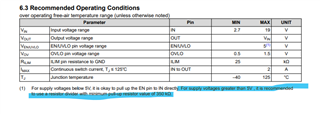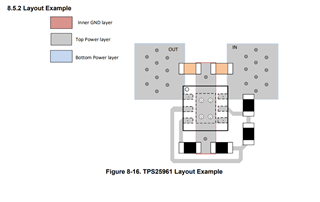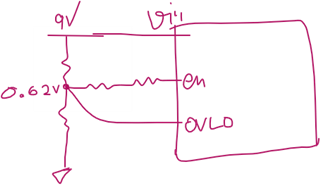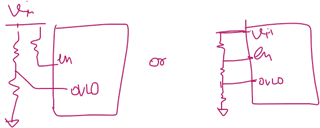- Ask a related questionWhat is a related question?A related question is a question created from another question. When the related question is created, it will be automatically linked to the original question.
This thread has been locked.
If you have a related question, please click the "Ask a related question" button in the top right corner. The newly created question will be automatically linked to this question.
Tool/software:
Hello,
i am interested in the efuse TPS25961 device and would like to use it on 9v and 12v output power that i have. the rail switches between 9v and 12v by a switch so the efuse must tolerate up to 12v.
i do not require under or over voltage protection so i decided to hook EN pin directly to Vin, and VLO pin to ground. is this ok? should i put 100k series resistor or direct connections are ok?
as for current limit i hoped to get it to work with 400mA or at least 350 mA but the resistor values lie in table 7.1 forbidden resistor values. I settled on 147k for 340mA but I hope to get it to 400mA, is that possible? how?
regards,
here is my final circuit.
please check and see if it will perform as intended. 147k is for about 340mA and I don't need any under voltage or over voltage protection, just regular operation.
Hello,
any news on this? i am really waiting for this to proceed with design.
Arush Gupta
Hi Hossam,
Thank you for your patience. We had some holidays last week hence the delayed response.
Can you reshare the schematic. This is not loading the schematic when I am opening this link. It is better to just paste a snip of your schematic here or upload a pdf file here.
i am interested in the efuse TPS25961 device and would like to use it on 9v and 12v output power that i have. the rail switches between 9v and 12v by a switch so the efuse must tolerate up to 12v.
eFuse will handle this voltage
i do not require under or over voltage protection so i decided to hook EN pin directly to Vin, and VLO pin to ground. is this ok? should i put 100k series resistor or direct connections are ok?
No issue in connecting OVLO to GND to disable the overvoltage protection.
Please use 350kOhms resistor for pullup when connecting the EN to Vin.

as for current limit i hoped to get it to work with 400mA or at least 350 mA but the resistor values lie in table 7.1 forbidden resistor values. I settled on 147k for 340mA but I hope to get it to 400mA, is that possible? how?
Yes, 147k should be good but please do keep in mind that this device will have worst case +/- 20% current limit accuracy. Are you fine with this in your application?
You can select values which are forbidden in table 7-1 at a possibility of higher R_on value. You can evaluate this if R_on is not a big consideration here.
Best Regards,
Arush
Hello,
here is the update image link: https://i.slow.pics/4DQ7F26E.png or https://slow.pics/4DQ7F26E/
and the image is also inserted here:

Notes:
- I updated EN pin pull-up resistor to be 390k instead of 100k, based on your recommendation.
- ILIM resistor R10 is now either 147k for 340mA or 162k for 308mA. I could just go with 162k since it is the value I use.
- input to the device is either 9v or 12v based on LM317M circuit shown which was tested to be working fine.
so here are my questions:
1- is the circuit now fully ok?
2- connecting OVLO directly to ground, is it ok or it must use a resistor?
3- what are the protections offered in my circuit above and what limits? I mean over voltage, under voltage, etc...
4- is this device expected to get hot when passing 100-300 mA of current? if so, putting some thermal vias can help remove the heat?
best regards!
Hi!
connecting OVLO directly to ground, is it ok or it must use a resistor?
Yes, it can be directly connected to GND.
what are the protections offered in my circuit above and what limits? I mean over voltage, under voltage, etc...
You will get UVP and OCP, SCP, output slew rate control. (please datasheet for more details)
is this device expected to get hot when passing 100-300 mA of current? if so, putting some thermal vias can help remove the heat?
power dissipation during steady state will be I^2*Ron which will be in order of mW but in case of any portection features or during startup, device will see higher power dissipation so thermal vias are good idea.
Here is the layout guideline from the datasheet.

Best Regards,
Arush
hello,
for default values when the device is operating correctly, assuming OVLO is connected to ground and EN connected to input power by 390k ohm resistor.... the values will be:
over-voltage threshold = 5.98v typical.
under-voltage lockout = 2.42v typical.
if so, then for my 9v and 12v supply... it won't start right? because it will have over-voltage of about 6v while input is always 9v or 12v...
thus i need to make a divider like R1=162k and R2=12k ---> by doing this I will have over-voltage value of 16.414v which seems ok and won't be reached anyway.
so according to this, i need to keep EN pin connected to Vin with 390k resistor and put a divider from VIN to OVLO pin which has upper resistor as 162k and lower resistor as 12k.
please check this and kindly give me confirmation.
thanks!!
Hi Hossam,
It looks like you are right. I made a mistake here. Generally we don't have any default OVLO level but it looks like in this device, we have default OVLO threshold which is activated when the device OVLO pin is connected to GND.
I apologies for creating confusion.
so according to this, i need to keep EN pin connected to Vin with 390k resistor and put a divider from VIN to OVLO pin which has upper resistor as 162k and lower resistor as 12k.
Yes, this looks correct. Separate OVLO resistor ladder and EN pull up.
Best Regards,
Arush
hello,
yes hhh i suspected you made a mistake, don't worry we all do.
I have changed it to use 3x 162k resistors in series for EN pin which is gonna be 486k combined, well above 350k minimum requirement.
I took the first 162k resistor and used it with 12k resistor to act as a voltage divider to get it to OLVO pin.
please see the image: https://slow.pics/c/miVBLKcL or https://i.slow.pics/aRvQorhU.png

please check my resistors and inform me if it is gonna be correct or not. using this i achieved the same as previous configuration... the only difference is i used 162k resistor value instead of getting a new value.
once you kindly confirm this, i can consider it solved.
thanks
Hi Hossam,
This won't work.

En will only see 0.62V in this case which is less than the required threshold. It will be better to use separate resistive ladder and pull up resistor.

Best Regards,
Arush
hello,
i thought 3 series resistors from 9v to EN pin will be ok. they are not referenced to ground but rather act as one big resistor. it is not the same as your first drawing since you referenced it to ground.
looks like the best choice is to get a separate resistor for EN which is 390k, and separate divider for OVLO which is R_top=162k, R_bot=12k.
Yes, that should work.
Hossam, I think this issue is resolved. I am closing the thread. You can create new thread or reply back here for any follow up questions.
Best Regards,
Arush
Hello

now is the updated schematic.
divider of 162k upper + 12k lower resistors will give over voltage of about 16.38v.
390k resistor from input to EN will make it always enabled.
162k ILimit resistor will make it 308 mA trip current.
all correct now?
Hello Arush,
thanks for your help. I will use this circuit.
finally i wanted to know few last things about the behavior of this device:
1- will the set points we made above for EN, UVLO, ILIM change if the input supply changed from 9v to 12v and vice versa?
2- if short circuit happened, does it need to turn the power off then on to resume or it will automatically restart?
3- if short circuit happened and the short continued to exist (and over current not just short)... will the device stay off? will there be any damage?
regards!
Hi Hossam,
1. Please refer datasheet section 7.3.1
2. datasheet refer 7.3.3.3
3. datasheet refer 7.3.3.3
Best Regards,
Arush